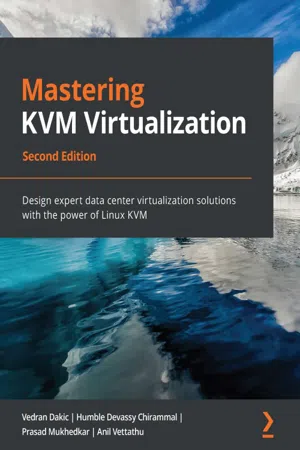
Mastering KVM Virtualization
- 686 pages
- English
- ePUB (mobile friendly)
- Available on iOS & Android
Mastering KVM Virtualization
About This Book
Learn how to configure, automate, orchestrate, troubleshoot, and monitor KVM-based environments capable of scaling to private and hybrid cloud modelsKey Features• Gain expert insights into Linux virtualization and the KVM ecosystem with this comprehensive guide• Learn to use various Linux tools such as QEMU, oVirt, libvirt, Cloud-Init, and Cloudbase-Init• Scale, monitor, and troubleshoot your VMs on various platforms, including OpenStack and AWSBook DescriptionKernel-based Virtual Machine (KVM) enables you to virtualize your data center by transforming your Linux operating system into a powerful hypervisor that allows you to manage multiple operating systems with minimal fuss. With this book, you'll gain insights into configuring, troubleshooting, and fixing bugs in KVM virtualization and related software.This second edition of Mastering KVM Virtualization is updated to cover the latest developments in the core KVM components - libvirt and QEMU. Starting with the basics of Linux virtualization, you'll explore VM lifecycle management and migration techniques. You'll then learn how to use SPICE and VNC protocols while creating VMs and discover best practices for using snapshots. As you progress, you'll integrate third-party tools with Ansible for automation and orchestration. You'll also learn to scale out and monitor your environments, and will cover oVirt, OpenStack, Eucalyptus, AWS, and ELK stack. Throughout the book, you'll find out more about tools such as Cloud-Init and Cloudbase-Init. Finally, you'll be taken through the performance tuning and troubleshooting guidelines for KVM-based virtual machines and a hypervisor.By the end of this book, you'll be well-versed with KVM virtualization and the tools and technologies needed to build and manage diverse virtualization environments.What you will learn• Implement KVM virtualization using libvirt and oVirt• Delve into KVM storage and network• Understand snapshots, templates, and live migration features• Get to grips with managing, scaling, and optimizing the KVM ecosystem• Discover how to tune and optimize KVM virtualization hosts• Adopt best practices for KVM platform troubleshootingWho this book is forIf you are a systems administrator, DevOps practitioner, or developer with Linux experience looking to sharpen your open-source virtualization skills, this virtualization book is for you. Prior understanding of the Linux command line and virtualization is required before getting started with this book.
Frequently asked questions
Information
Section 1: KVM Virtualization Basics
- Chapter 1, Understanding Linux Virtualization
- Chapter 2, KVM as a Virtualization Solution
Chapter 1: Understanding Linux Virtualization
- Linux virtualization and its basic concepts
- Types of virtualization
- Hypervisor/VMM
- Open source virtualization projects
- What Linux virtualization offers you in the cloud
Linux virtualization and how it all started
Types of virtualization
- Desktop virtualization (Virtual Desktop Infrastructuree (VDI)): This is used by a lot of enterprise companies and offers huge advantages for a lot of scenarios because of the fact that users aren't dependent on a specific device that they're using to access their desktop system. They can connect from a mobile phone, tablet, or a computer, and they can usually connect to their virtualized desktop from anywhere as if they're sitting at their workplace and using a hardware computer. Benefits include easier, centralized management and monitoring, much more simplified update workflows (you can update the base image for hundreds of virtual machines in a VDI solution and re-link that to hundreds of virtual machines during maintenance hours), simplified deployment processes (no more physical installations on desktops, workstations, or laptops, as well as the possibility of centralized application management), and easier management of compliance and security-related options.
- Server virtualization: This is used by a vast majority of IT companies today. It offers good consolidation of server virtual machines versus physical servers, while offering many other operational advantages over regular, physical ...
Table of contents
- Mastering KVM Virtualization Second Edition
- Why subscribe?
- Preface
- Section 1: KVM Virtualization Basics
- Chapter 1: Understanding Linux Virtualization
- Chapter 2: KVM as a Virtualization Solution
- Section 2: libvirt and ovirt for Virtual Machine Management
- Chapter 3: Installing KVM Hypervisor, libvirt, and oVirt
- Chapter 4: Libvirt Networking
- Chapter 5: Libvirt Storage
- Chapter 6: Virtual Display Devices and Protocols
- Chapter 7: Virtual Machines: Installation, Configuration, and Life Cycle Management
- Chapter 8: Creating and Modifying VM Disks, Templates, and Snapshots
- Section 3: Automation, Customization, and Orchestration for KVM VMs
- Chapter 9: Customizing a Virtual Machine with cloud-init
- Chapter 10: Automated Windows Guest Deployment and Customization
- Chapter 11: Ansible and Scripting for Orchestration and Automation
- Section 4: Scalability, Monitoring, Performance Tuning, and Troubleshooting
- Chapter 12: Scaling Out KVM with OpenStack
- Chapter 13: Scaling out KVM with AWS
- Chapter 14: Monitoring the KVM Virtualization Platform
- Chapter 15: Performance Tuning and Optimization for KVM VMs
- Chapter 16: Troubleshooting Guidelines for the KVM Platform
- Other Books You May Enjoy